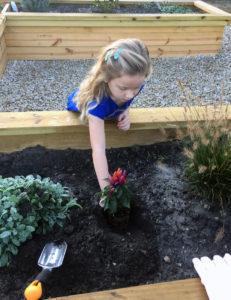I wonder how you feel about mathematics? Trust me, school days have left many of us feeling ‘unfriendly’ towards mathematics. Remember how it seemed like a shadowy world back then?! Mostly the fear of making a mistake or being slow to get the correct answer may have inhibited us from enjoying each problem & challenge. But in today’s quantitative world, it’s important that kids grow up with a positive attitude towards maths. When we raise our children to believe that they “hate math” or are “bad at math”, we are hampering their possibilities in terms of both Life Skills and the job market. So what’s a Parent to do? Is there a way you can encourage mathematical thinking in your child beyond the classroom?

For many children, their feelings about math change right around fifth grade. It’s either overwhelmingly hard, or frustratingly boring. And that’s where your role as a Parent comes in. So why not utilise opportunities from daily life to enrich your child’s mathematical environment!
You may also like to read “5 Basic Life Skills your Child Must Learn”
Here are some simple ways of encouraging mathematical thinking, which parents and kids can enjoy together.
1. Meal time

Mathematics & meals…sounds odd? But believe it or not, from cooking, serving & setting up the table to ordering food at the restaurant with a budget in hand- there are ample opportunities to encourage the use of numbers, logic and geometry!
- Involve your child in rolling out the dough and cutting out cookies of different shapes. For older kids, make it a bit more interesting by talking about the perimeter, radius etc.
- Place a recipe book in the front and involve your child in measuring quantities accurately. Using weighing scale, clock, timer etc reinforces the skill of reading these numbers and draws on knowledge of decimals.
- Fractional concepts can be developed when cutting the cake or pizza into equal parts.
- For younger kids, talk about the number of plates, napkins and glasses while setting the table.
- Reading the time from clock to know when the dish would be ready not only uses knowledge of time, but also encourages basic number strategies to be practised: The recipe says ˜chill for 30 minutes. It’s 10.50 am now, when will it be ready?
- While eating out, ask your child to give rough estimate of the bill total. Or calculate the service charge that needs to be paid as per the %.
2. Shopping Time

When you’re out grocery shopping, there are plenty of ways to get kids thinking about and exploring maths. Budgeting, comparing prices and calculating change are all skills that can be practiced in real-life situation.
- For young kids it can be simple counting exercises to reinforce early number concepts like: 1, 2, 3, 4, 5. We have 5 apples in the bag.
- Another number concept easily practised at the shops is comparison like : Do we have more apples or oranges?
- For older kids, share a fixed budget & ask them to plan their purchases within the set amount. The way kids strategise, compare prices and make their choices is an important life skill. In the process keep throwing challenges like: This coupon gives us 15% off our total bill. How much will we save if our bill is Rs 800?
- Add more fun to this by handing over Rs 100 note and a small shopping list. This would not only develop mathematical thinking but also foster a sense of independence.
3. Laundry time

This basic household job can be a great number loving activity for kids, provided you make it fun! Sorting, counting, estimation- all this can be practiced here.
- As you sort the laundry, ask your child to make a pile of shirts & trousers. Ask him which pile is the bigger (estimation). Together, count how many shirts are there.
- Ask the child to make pairs of socks (Don’t worry if they don’t match! This activity is more about counting than matching)
4. While Traveling

I have spoken abut this earlier how time spent together in the car or generally while travelling as a family can help build several Life Skills in kids like communication & creativity. It’s also a wonderful opportunity to get the grey cells working for your child! From pointing out & reading aloud speed limits signs to planning number of halts in the journey- traveling encourages kids to think about the question and plan a method for finding a solution.
- In the car, ask her how long it will take to travel to your destination based on your speed (remember the speed-distance-time formula?) : If the speed limit is 100km, what is the latest time we can leave to arrive by 4pm?
- Involve them in calculating mileage while getting the tank refuelled: If we’ve used half a tank of gas, when should we refuel?
- Encourage use of paper maps- it’s an interesting way to practise computation skills and develops an interest in map reading
- Stuck in a jam? No problem! Talk about the number of cars in front or behind!
You may also like to read “30 Healthy Travel Snacks for your Baby”
5. In the Garden

Spending time outdoors can give you enough opportunities to harness your child’s enthusiasm and develop math skills at the same time.
- Involve your child in estimating the position while sowing new plants in the kitchen garden or while digging the hole for the plant. The guess and check process is an essential problem-solving strategy.
- Add a few concepts of geometry and multiplication while designing the layout of your vegetable garden.
- Don’t have a green thumb? Don’t worry…simply taking a walk around the park gives children many opportunities to compare (which stone is bigger?), assess (how many steps to the rides?), note similarities and differences (different flowers with varied colours) and categorize (see if you can find some dried leaves). For younger kids you can start with only counting practice (let’s count how many steps until we get to the corner).
You may also like to read “Why the Outdoors is the Best Playground for your Child”
See how Parents can easily use everyday experiences to reinforce and develop mathematical skills and support their child’s learning of this important subject area beyond the classroom.
But what if you have Math phobias yourself? Certainly those dry math worksheets & repetitive homework problems are giving you sleepless nights!
The thought of teaching math can be intimidating, especially for Parents who have math phobias themselves. So through their Play, Others & Downtime approach, Dolphin POD is working towards bringing about a paradigm shift in the way learning and education is seen. They believe that it can be easier when the learning involves colours, music, games and a bit of downtime!
Their age-relevant carefully curated content and methodology based on neuro-scientific methods is aimed at making children smarter, healthier, happier and better equipped to operate in the constantly evolving, ambitious and cohesive society. The activities crafted at Dolphin POD show how learning can be seen from a different lens and blend into routine activities that nurture the essential Life Skills of a child for the 21st century.
Psst…Stop saying that you yourself are bad at math, or hate math…don’t even grumble this while checking the bill at the restaurant! Kids absorb these messages, even if you aren’t directly talking with them.
Go Mommy!

Thanks a lot for the wonderful tips. Just in time for me.
I love math, and your suggestions are totally appealing to me — so I’m guessing my kids are going to either be embarrassed by Mom’s enthusiasm for math, or totally get hooked as well 😉
The grocery store is a great place to practice math! Even my 5 y/o likes to read the price sighs.
We have chickens and the kids really enjoy simple math problems dealing with the chickens. Something like “We have 6 hens that lay green eggs. I gathered 4 green eggs today. How many hens did not lay a green egg today?”
Another great way is just through board games! We play a lot of board games to practice math, especially for the younger kids.
That’s a wonderful medium of course! Board games like monopoly was our first introduction to the concept of currency back then. Thank you for reading through and sharing your views.
These are some wonderful suggestions. We include and look for maths in every thing in daily life. 🙂
These are wonderful suggestions. I’d never have thought of half of these for helping kids learn math outside the classroom!
This is a mine of information on how to get children to enjoy maths outside school or classroom. Learning how to use them in daily life will make them enjoy it rather than hate it
Great tips and agree with you. If we make it fun, it’s always easier for kids to learn and enjoy the subject.
Good way to inculcate mathematical skills in your child.
Very interesting.i have a 2yo and I can start now..thanks for sharing
Wow. These are so many ways we can encourage thinking. Thanks for sharing mama
Thank you. I am glad you found the article helpful.
Liked the entire idea of simple methods of inculcating habit of solving everyday mathematics problems.will implement these for my son.
what an amazing post. its wonderful how we can help them learn with association. if its fun, its easier to learn for them.
Love the Meal Time tips – so cute and so fun! I will def do these with my little one
Glad to know that you found the tips relevant and helpful!
Wow, these are such simple tips and easy to follow as well. Especially the meal time tips are amazing.
Thanks Tamanna.. I am glad you found the article helpful.
These activities can be easily performed at home and kids will love to involve also. Counting and making things same time will entertain them
Thank you. I am glad you found the article helpful.
Never thought of introducing the maths to kids in so many fun and innovative ways . Most of them are really easy to incorporate in our daily routine lives
Thank you. I am glad you found the article helpful. Yes, the idea is to make simple calculations & mathematical concepts a part of everyday life. Fear of numbers goes down this way.
Now these are some tips that one may keep up their sleeve as these do not need much preparations beforehand. They are like on the go kind of activities and discussions
Thank you. I am glad you found the article helpful.
Amazing tips… I was afraid of maths all the time,but will try to make it more fun for my kid..
Thank you. I am glad you found the article helpful.
I love how each of these require real-life applications for math. Too often kids ask, “When am I ever going to use this?” when it comes to math. This post and these ideas definitely answer that question!
Thanks Kristen. Yes, you are right. The idea is to use basic calculation & mathematical concepts and imbibe them in your child’s routine. At this stage in life I feel science and maths are two very relevant subjects in everyday life.